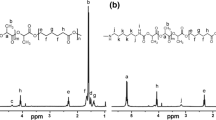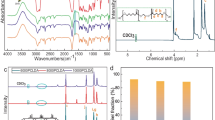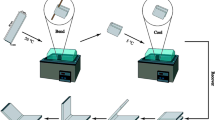Abstract
Two-way shape memory polymer can exhibit reversible shape transformation, which shows great application potential as a smart material. It is necessary to develop new reversible shape memory composite systems to achieve accurate and wide-range control of two-way shape memory behavior, especially under the condition of no external force. A chemically cross-linked two-component crystalline block copolymer was prepared, and the mechanism of two-way shape memory behavior under stress-free condition of the material was revealed. The results show that both the crystallization and thermal property of PLA/PCL-PU can be significantly changed by adjusting the proportion between PLA and PCL, and the dosage of crosslinking agent, and thus the shape memory property of PLA/PCL-PU can be regulated accordingly. The two-way shape recovery rate of the material can reach to 41.11%. This work provides a facile strategy to fabricate a biodegradable thermally induced two-way shape memory material under the stress-free condition with tunable shape memory properties.












Similar content being viewed by others
Data availability
The datasets generated during and/or analyzed during the current study are available from the corresponding author on reasonable request.
References
Miao W, Zou W, Jin B, Ni C, Zheng N, Zhao Q, Xie T (2020) On demand shape memory polymer via light regulated topological defects in a dynamic covalent network. Nat Commun 11:1–8. https://doi.org/10.1038/s41467-020-18116-1
Fang Y, Ni Y, Leo SY, Taylor C, Basile V, Jiang P (2015) Reconfigurable photonic crystals enabled by pressure-responsive shape-memory polymers. Nat Commun 6:1–8. https://doi.org/10.1038/ncomms8416
Yang Y, Urban MW (2013) Self-healing polymeric materials. Chem Soc Rev 17:7446–7467. https://doi.org/10.1039/c3cs60109a
Hager MD, Bode S, Weber C, Schubert US (2015) Shape memory polymers: past, present and future developments. Prog Polym Sci 3–33. https://doi.org/10.1016/j.progpolymsci.2015.04.002
Roy N, Bruchmann B, Lehn J-M (2015) DYNAMERS: dynamic polymers as self-healing materials. Chem Soc Rev 11:3786–3807. https://doi.org/10.1039/c5cs00194c
Xiao X, Kong D, Qiu X, Zhang W, Zhang F, Liu L, Liu Y, Zhang S, Hu Y, Leng J (2015) Shape-memory polymers with adjustable high glass transition temperatures. Macromolecules 11:3582–3589. https://doi.org/10.1021/acs.macromol.5b00654
Fan X, Chung JY, Lim YX, Li Z, Loh XJ (2016) Review of adaptive programmable materials and their bioapplications. Acs Appl Mater Interfaces 49:33351–33370. https://doi.org/10.1021/acsami.6b09110
Le X, Lu W, Zheng J, Tong D, Zhao N, Ma C, Xiao H, Zhang J, Huang Y, Chen T (2016) Stretchable supramolecular hydrogels with triple shape memory effect. Chem Sci 11:6715–6720. https://doi.org/10.1039/c6sc02354a
Wang W, Liu Y, Leng J (2016) Recent developments in shape memory polymer nanocomposites: actuation methods and mechanisms. Coord Chem Rev 38–52. https://doi.org/10.1016/j.ccr.2016.03.007
Xiao Y-Y, Gong X-L, Kang Y, Jiang Z-C, Zhang S, Li B-J (2016) Light-, pH- and thermal-responsive hydrogels with the triple-shape memory effect. Chem Commun 70:10609–10612. https://doi.org/10.1039/c6cc03587f
Zheng N, Fang Z, Zou W, Zhao Q, Xie T (2016) Thermoset shape-memory polyurethane with intrinsic plasticity enabled by transcarbamoylation. Angew Chem Int Ed 38:11421–11425. https://doi.org/10.1002/anie.201602847
Liu J, Liu J, Wang S, Huang J, Wu S, Tang Z, Guo B, Zhang L (2017) An advanced elastomer with an unprecedented combination of excellent mechanical properties and high self-healing capability. J Mater Chem A 48:25660–25671. https://doi.org/10.1039/c7ta08255j
Mu T, Liu L, Lan X, Liu Y, Leng J (2018) Shape memory polymers for composites. Compos Sci Technol 169–198. https://doi.org/10.1016/j.compscitech.2018.03.018
Lendlein A, Gould OEC (2019) Reprogrammable recovery and actuation behaviour of shape-memory polymers. Nat Rev Mater 2:116–133. https://doi.org/10.1038/s41578-018-0078-8
Wang S, Urban MW (2020) Self-healing polymers. Nat Rev Mater 8:562–583. https://doi.org/10.1038/s41578-020-0202-4
Wen N, Song T, Ji Z, Jiang D, Wu Z, Wang Y, Guo Z (2021) Recent advancements in self-healing materials: mechanicals, performances and features. React Funct Polym. https://doi.org/10.1016/j.reactfunctpolym.2021.105041
Hia IL, Vahedi V, Pasbakhsh P (2016) Self-healing polymer composites: prospects, challenges, and applications. Polym Rev 2:225–261. https://doi.org/10.1080/15583724.2015.1106555
Pilate F, Toncheva A, Dubois P, Raquez J-M (2016) Shape-memory polymers for multiple applications in the materials world. Eur Polym J 268–294. https://doi.org/10.1016/j.eurpolymj.2016.05.004
Amaral AJR, Pasparakis G (2017) Stimuli responsive self-healing polymers: gels, elastomers and membranes. Polym Chem 42:6464–6484. https://doi.org/10.1039/c7py01386h
Kim Y-J, Matsunaga YT (2017) Thermo-responsive polymers and their application as smart biomaterials. J Mater Chem B 23:4307–4321. https://doi.org/10.1039/c7tb00157f
Miriyev A, Stack K, Lipson H (2017) Soft material for soft actuators. Nat Comm. https://doi.org/10.1038/s41467-017-00685-3
Zhao Q, Qi HJ, Xie T (2015) Recent progress in shape memory polymer: new behavior, enabling materials, and mechanistic understanding. Prog Polym Sci 79–120. https://doi.org/10.1016/j.progpolymsci.2015.04.001
Jiang D, Wang Y, Li B, Sun C, Wu Z, Yan H, Xing L, Qi S, Li Y, Liu H, Xie W, Wang X, Ding T, Guo Z (2019) Flexible sandwich structural strain sensor based on silver nanowires decorated with self-healing substrate. Macromol Mater Eng. https://doi.org/10.1002/mame.201900074
Zare M, Prabhakaran MP, Parvin N, Ramakrishna S (2019) Thermally-induced two-way shape memory polymers: mechanisms, structures, and applications. Chem Eng J 706–720. https://doi.org/10.1016/j.cej.2019.05.167
Zhao Q, Zou W, Luo Y, Xie T (2016) Shape memory polymer network with thermally distinct elasticity and plasticity. Sci Adv. https://doi.org/10.1126/sciadv.1501297
Wang Y, Jiang D, Zhang L, Li B, Sun C, Yan H, Wu Z, Liu H, Zhang J, Fan J, Hou H, Ding T, Guo Z (2020) Hydrogen bonding derived self-healing polymer composites reinforced with amidation carbon fibers. Nanotechnology. https://doi.org/10.1088/1361-6528/ab4743
Wen N, Zhang L, Jiang D, Wu Z, Li B, Sun C, Guo Z (2020) Emerging flexible sensors based on nanomaterials: recent status and applications. J Mater Chem A 48:25499–25527. https://doi.org/10.1039/d0ta09556g
Xia Y, He Y, Zhang F, Liu Y, Leng J (2021) A review of shape memory polymers and composites: mechanisms, materials, and applications. Adv Mater. https://doi.org/10.1002/adma.202000713
Xu H, Yu C, Wang S, Malyarchuk V, Xie T, Rogers JA (2013) Deformable, programmable, and shape-memorizing micro-optics. Adv Funct Mater 26:3299–3306. https://doi.org/10.1002/adfm.201203396
Ge Q, Sakhaei AH, Lee H, Dunn CK, Fang NX, Dunn ML (2016) Multimaterial 4D printing with tailorable shape memory polymers. Sci Rep. https://doi.org/10.1038/srep31110
Zarek M, Layani M, Cooperstein I, Sachyani E, Cohn D, Magdassi S (2016) 3D printing of shape memory polymers for flexible electronic devices. Adv Mater 22:4449–+. https://doi.org/10.1002/adma.201503132
Lee AY, An J, Chua CK (2017) Two-way 4D printing: a review on the reversibility of 3D-printed shape memory materials. Engineering 5:663–674. https://doi.org/10.1016/j.Eng.2017.05.014
Jin B, Song H, Jiang R, Song J, Zhao Q, Xie T (2018) Programming a crystalline shape memory polymer network with thermo- and photo-reversible bonds toward a single-component soft robot. Sci Adv. https://doi.org/10.1126/sciadv.aao3865
Kuang X, Chen K, Dunn CK, Wu J, Li VCF, Qi HJ (2018) 3D Printing of highly stretchable, shape-memory, and self-healing elastomer toward novel 4D printing. Acs Appl Mater Interfaces 8:7381–7388. https://doi.org/10.1021/acsami.7b18265
Deng Z, Hu T, Lei Q, He J, Ma PX, Guo B (2019) Stimuli-responsive conductive nanocomposite hydrogels with high stretchability, self-healing, adhesiveness, and 3D printability for human motion sensing. Acs Appl Mater Interfaces 7:6796–6808. https://doi.org/10.1021/acsami.8b20178
Shintake J, Cacucciolo V, Floreano D, Shea H (2018) Soft robotic grippers. Adv Mater. https://doi.org/10.1002/adma.201707035
Liu JAC, Gillen JH, Mishra SR, Evans BA, Tracy JB (2019) Photothermally and magnetically controlled reconfiguration of polymer composites for soft robotics. Sci Adv. https://doi.org/10.1126/sciadv.aaw2897
Zhang Y-F, Zhang N, Hingorani H, Ding N, Wang D, Yuan C, Zhang B, Gu G, Ge Q (2019) Fast-response, stiffness-tunable soft actuator by hybrid multimaterial 3D printing. Adv Funct Mater. https://doi.org/10.1002/adfm.201806698
Zhao W, Liu L, Zhang F, Leng J, Liu Y (2019) Shape memory polymers and their composites in biomedical applications. Mater Sci Eng C Mater Biol Appl 864–883. https://doi.org/10.1016/j.msec.2018.12.054
Behl M, Kratz K, Zotzmann J, Noechel U, Lendlein A (2013) Reversible bidirectional shape-memory polymers. Adv Mater 32:4466–4469. https://doi.org/10.1002/adma.201300880
Funding
This work is supported by the Natural Science Foundation of Heilongjiang Province of China (E2018003), the Fundamental Research Funds for the Central Universities (2572018BC31), and the National Natural Science Foundation of China (52273066).
Author information
Authors and Affiliations
Contributions
H. Yang and R. Shi contributed to the study conception and design. Material preparation and data collection were performed by H. Yang and R. Shi. H. Yang, R. Shi, Q. Jiang, and J. Ren conducted data analysis and discussion. The manuscript was written by H. Yang, R. Shi, Q. Jiang, and J. Ren. All authors read and approved the final manuscript.
Corresponding author
Ethics declarations
Conflict of interest
The authors declare no competing interests.
Additional information
Publisher's Note
Springer Nature remains neutral with regard to jurisdictional claims in published maps and institutional affiliations.
Rights and permissions
Springer Nature or its licensor (e.g. a society or other partner) holds exclusive rights to this article under a publishing agreement with the author(s) or other rightsholder(s); author self-archiving of the accepted manuscript version of this article is solely governed by the terms of such publishing agreement and applicable law.
About this article
Cite this article
Yang, H., Shi, R., Jiang, Q. et al. Properties and mechanism of two-way shape memory polyurethane composite under stress-free condition. Adv Compos Hybrid Mater 6, 1 (2023). https://doi.org/10.1007/s42114-022-00585-1
Accepted:
Published:
DOI: https://doi.org/10.1007/s42114-022-00585-1




